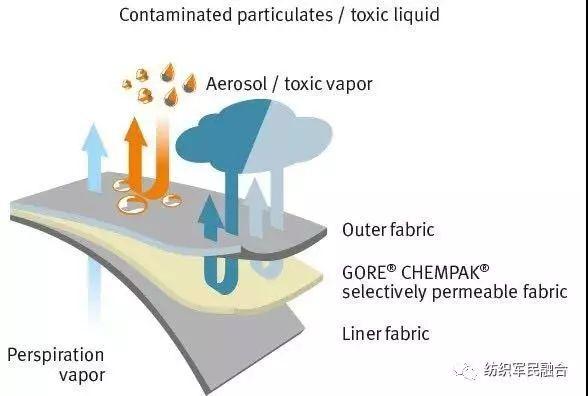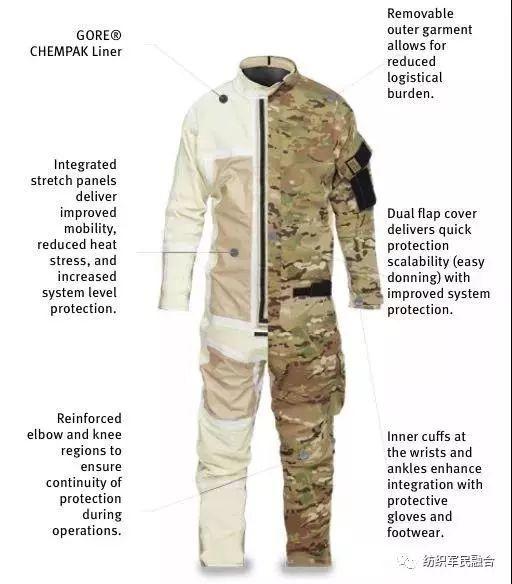Development status and latest research progress of breathable anti-virus clothing (2)
In order to better cope with emergencies such as biochemical warfare, terrorist attacks and dangerous chemical spills, the future biochemical protective equipment is bound to develop in the direction of multi-functionalization, integration and lightening. Adsorbent materials such as activated carbon have been developed in various developed countries. There are relatively mature products, but there are still some problems with activated carbon adsorption. Therefore, developed countries are actively developing new protective materials, such as self-cleaning materials, selective transmission of protective materials, metal-organic framework materials, nanofibers and microcapsule self-repairing technology. These aspects have become the focus of research on light biochemical protective clothing in various countries. The following is a brief introduction to the latest research progress of several new materials and technologies in breathable anti-virus clothing.

Selective transmission type protective material
In recent years, in order to reduce the quality of anti-virus clothing and solve some problems in the adsorption of activated carbon, domestic and foreign researchers have conducted a lot of research on alternative carbon adsorption layer materials, and have relatively mature products. Gore developed a protective suit called "Chempak" that selectively shields toxic chemicals, viruses and bacteria. The protective clothing fabric has a sandwich structure, and the middle core layer uses a PTFE film having a gram weight of 10 to 29 g/m2. The protective suit is 51% lighter than the US Army Combat Service (BDO) and 45% lighter than the US Army Joint Armor Lightweight Comprehensive Protective Clothing (JSLIST). It has a series of light weight, low density, comfortable wearing, excellent shielding ability of biological and chemical agents. advantage. The structure of the Chempak protective suit is shown in the figure.


Protective clothing structure using chempak material
Scientists in the United States and Germany have jointly developed a protective fabric called "Spiratec Hybrid", which combines membrane technology with adsorption technology. The inner layer is made of selective permeable membrane (SPM), activated carbon and soft. Fabric composition. The composite fabric can provide multiple layers of protection, and the selective permeable membrane provides initial protection, which can avoid the influence of some natural conditions such as wind and water on the adsorption performance of activated carbon, and can reduce the amount of activated carbon and reduce the quality of protective clothing. Thermal resistance. The protective fabric protects against various types of biological viruses, bacteria and chemical agents, and its anti-anthrax simulator penetration performance is 20 to 90 times higher than that of the SARATOGA combat suit.
Microcapsule self-repair technology
Self-healing materials are the ability to mimic life systems, sense environmental changes, and react in real time to self-repair and heal after injury without the involvement of the external environment. Among the many self-repair materials, microcapsules have good compatibility with polymer matrix, and at the same time, they have become the most widely used and well-developed methods in the field of self-healing coatings due to their suitable mechanical properties and good thermal stability. Among them, a repair system consisting of a dicyclopentadiene (DCPD) repair agent and a Grubbs catalyst is reported. Since 2001, White et al. first reported the self-repair mechanism of microcapsules. In the following decade, microcapsule self-repair technology has received extensive attention from researchers.
At present, the US military's weapons and equipment self-repair technology is still in the stage of research and development and preliminary application. Its repair technology includes biochemical protective clothing self-repair, military electronic circuit self-repair, defense work self-repair, military vehicle rust self-repair and flight control self-repair. On November 19, 2015, according to the US Army website, the US Army Natick Soldier Research and Development and Engineering Center (NSRDEC) and other agencies are working together to develop biochemical protective clothing self-healing coating technology. The technology will be applied to the US Army's Three Army Lightweight Integrated Garment Technology (JSLIST) project and the US Army Three Army Pilot Protective Suit (JPACE) project. The protective mechanism of the JPACE military uniform is based on a selectively permeable membrane. Therefore, the microcapsules containing the self-repairing fluid can be embedded in the selectively permeable membrane and/or in an auxiliary reactive selective permeable membrane layer. Self-healing auxiliary barrier material. When the film breaks, these microcapsules containing the self-repairing fluid are opened, and the cracks, cuts, holes, and punctures are repaired in a short period of time, and the gap filling is performed by the gap filling technique. The protective mechanism of the JSLIST protective suit is based on a non-woven material carrying activated carbon microspheres. Since the JSLIST protective suit is breathable, it is not easy to embed the microcapsules, it must be sprayed with microcapsules and a foaming agent.
Electrospinning technology
In recent years, electrospun nanofibers have been a hot topic in scientific research because of their unique properties. Electrospun nanofibers can be nanometer in diameter but can be in the kilometer range. The protective performance and air permeability of the previous protective clothing are two parameters that are opposite to each other, but the electrospun nanofiber can have better protection performance and air permeability without affecting the moisture permeability of the fabric. The electrospinning nanofiber membrane has high filtration efficiency for aerosols, and its penetration resistance is superior to that of current US military equipment BDO fabrics and JSLIST fabrics. Based on its various physical properties, it has obvious advantages in applying it to biochemical protective clothing.
The US Natick Soldier Research Center has been working on the development of electrospun nanofibers as a new generation of biochemical protective clothing fabrics, and has been reported more. Single electrospun nanofibers may have better strength, but mechanical strength on a macroscopic scale is not good. Graham et al. used JSLIST fabric as the support structure and composited the electrospun nylon nanofibers onto the JSLIST fabric. It was found that the two layers of electrospun nylon nanofiber sandwich were in the middle of the two-layer spunbond fabric. This combination avoids nanofibers. Direct friction, resulting in a more durable protective clothing fabric.
Nano-metal oxides have many characteristics such as large specific surface area, many surface defects, small crystal grains, etc. They have superior adsorption capacity to chemical warfare agents, viruses and bacteria, and have high catalytic degradation properties for chemical poisons. The ZnTiO3 nanofiber membrane was prepared by the electrospinning technology of Ramakrishna of the National University of Singapore. The prepared nanofiber membrane has a high specific surface area, which can adsorb chemical poisons and rapidly degrade the poison. The intermediate products are not toxicity. This nanofiber membrane can be used in the anti-poisoning suit instead of the activated carbon adsorption layer to reduce the quality of the protective clothing. Shi et al. prepared ZnO/nylon 6 nanofiber membrane by electrospinning technique. It was found that ZnO/nylon 6 nanofiber membrane has excellent antibacterial efficiency (99.99%) for both Gram-negative Escherichia coli and Bacillus cereus. In addition, the detoxification efficiency of ZnO/nylon 6 nanofiber membrane to nitrophenyl diethyl phosphate (neurotoxic agent) is over 95%. The ZnO/nylon 6 nanofiber membrane was loaded on a nylon/cotton fabric, which had little effect on the breathability and moisture permeability of the fabric.
Carbon nanotube
Recent studies have shown that carbon nanotubes (CNTs) have unique intrinsic cavity structures, monodisperse nanopore and transport properties, which can effectively promote the transfer rate of gas or liquid molecules. The transport speed of water molecules in the pores of carbon nanotubes is several orders of magnitude higher than theoretical calculations. Based on the ultra-fast gas and liquid transport capabilities of carbon nanotubes, it is hopeful for the future to make ultra-light, ultra-breathable thin, flap-like protective clothing.
Recently, FrancescoFornasiero et al. demonstrated a carbon nanotube film with a pore size of 5 nm or less, which can efficiently conduct water vapor and also block most of the virus and agent droplets. Experimental studies have found that carbon nanotube film is almost completely trapped for direct blue dye (size 3nm × 1nm × 1.5nm) and gold nanoparticles (size about 5nm), for Fe(CN)63- (size is about 0.95) The nm) rejection is approximately 55%. In addition, the researchers also compared the Dengue virus (size about 40 ~ 60nm) filtered by carbon nanotube film and PTFE membrane, and found that the PTFE membrane has almost no barrier effect on the virus, while the carbon nanotube The film is almost completely trapped against the virus.
More interestingly, the porosity of carbon nanotube film is only 4.4%~5.5%, but its vapor transmission rate is as high as 8000gr/(m2·d), which is the general protective clothing requirement (>1500gr/(m2·d)). 4 times more. In the next step, the researchers will continue their efforts in the "CNT surface modification", and strive to make ultra-light, ultra-breathable thin, flap-like protective clothing as soon as possible.
Metal-organic frame material
Metal-organic framework materials (MOFs) are structurally regular porous framework materials which are self-assembled by metal ions or clusters and organic ligands containing oxygen/nitrogen elements by coordination. They are a new type of organic-inorganic hybrid materials. . MOFs are widely used in gas storage and separation, sensors, biomedicine, and catalytic reactions due to their large specific surface area, high porosity, structural diversity, adjustable pore size and modified framework. In recent years, metal-organic frameworks (MOFs) have emerged in the field of chemical weapons protection and decontamination due to their regular pore size distribution, open framework structure, large specific surface area and ultra-high adsorption capacity. At present, various types of metal-organic framework materials based on copper, chromium, cerium, zirconium and polyoxometallate have been developed. A large number of research results show that various types of MOFs can effectively degrade and destroy chemical warfare agents and their mimics, and promote their basic research and application in the fields of public safety and military chemistry.
However, the synthesis of MOFs is quite complicated and cumbersome, usually requiring higher temperatures and longer reaction times, and most MOFs are unstable and usually require further processing. It is conceivable that adding MOFs to the fabric is extremely challenging.
Recently, Dennis Lee et al. placed a polypropylene fabric in a mixture of zirconium-based MOF, a solvent and two binders. In order to ensure that the coating was evenly distributed on the surface of the fabric, the alumina was coated on the fabric fibers. Thin layer treatment of titanium dioxide or zinc oxide. It has been found that a supramolecular complex composed of βG cyclodextrin and cetyltrimethylammonium bromide (CTAB) can be used as a self-assembling agent to achieve a high UiO-66-NH2 crystal on the fabric at room temperature. The load is shown in Figure 5. The fabric treated by MOFs deactivated the degradation of dimethyl phosphate within 5 min, indicating that the study may significantly improve the protective effect of protective clothing, and further ensure the safety of frontline soldiers and emergency personnel in the face of chemical weapons.
Self-cleaning material
Self-purifying materials are polymers or fabrics with self-cleaning function, which can quickly inhibit or kill a wide range of organisms, quickly purify toxic reagents, and ensure the safety of workers and the environment. Protective clothing made from this material will remain comfortable and breathable after prolonged use, and its use, storage and reuse, as well as biological and chemical durability, are much better than previous materials. Figure 6 is a schematic representation of a multifunctional polymer capable of purifying biological and chemical warfare agents. Compounds of the N-haloamine structure are widely used as disinfectants for swimming pools and are safe for humans. The introduction of new functional groups, such as N-haloamine structures, onto the polymer or fiber molecular chain by chemical modification can impart a self-cleaning function to the polymer or fiber to the biologic and chemical agents.
Many similar haloamine structures are unstable due to the presence of hydrogen adjacent to the amide bond. However, an aramid such as Nomex is exceptionally easy to convert to a stable haloamine structure. Nomex fiber is a commonly used fire-fighting clothing fabric. The chemical modification method is used to convert the NH of the polyamide into the N-Cl structure. The modification treatment has little effect on the mechanical properties and thermal properties of the fabric, and can be directly applied to the fire service and Military training uniforms. At the same time, the modified fabric showed good biological properties, and its biological properties remained unchanged after 3 months of storage or repeated washings. The modified fabric could quickly kill a broad spectrum of organisms; Additional cost.
Conclusion
In recent years, chemical weapons wars, terrorist attacks, and dangerous chemical spills have occurred frequently. The existing anti-drug suits using activated carbon as an adsorbent can meet the performance protection requirements, but there are secondary pollution, no selective adsorption, and Small molecule poisons or large poison droplets have poor adsorption effects. The emergence of some new materials and new technologies has brought hope to the development of high-performance, lightweight, comfortable and multi-functional biochemical protective equipment. It has received extensive attention from scholars at home and abroad, but it should also be noted that these new materials, The following problems still exist in new technologies: researchers need to continue to work hard to find out:
(1) The electrospinning yield is low, and the obtained material has limited mechanical strength, and it is difficult to control the number and pore diameter of the fiber.
(2) Microcapsules have poor heat resistance, poor dispersibility, and low interfacial bonding strength. The addition of microcapsules degrades the mechanical properties such as elastic modulus and tensile strength of the composite .
(3) The synthesis process of MOFs is complicated and cumbersome, requiring higher temperature and longer reaction time. Most of the MOFs powders are unstable and difficult to apply to fabrics.
(4) Most of the haloamine structures are not stable, and the prepared self-purifying materials have poor durability for the purification of biological warfare agents and chemical poisons.
Mens Nylon Underwear,Nylon Boxer Briefs,Antibacterial Function For Hygiene Nylon Underwear,Good Moisture Absorption Nylon Underwear
Liya Garment Limited Company , https://www.liyaunderwearformen.com